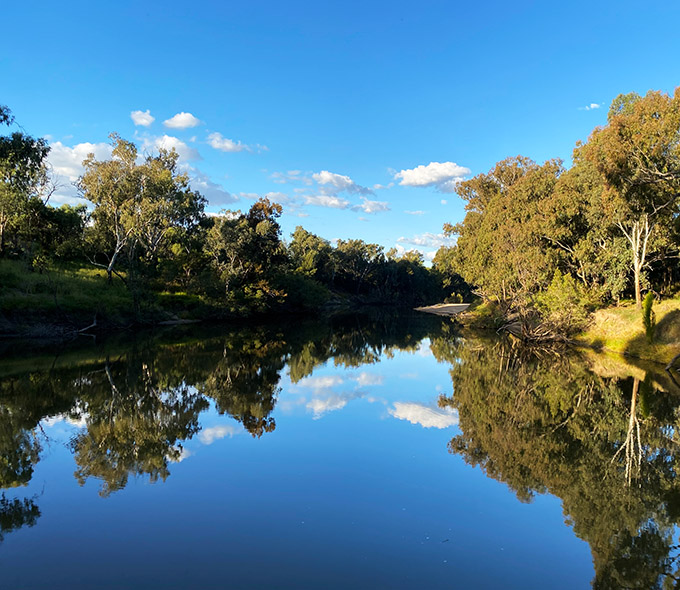It incorporates the Dumaresq, Macintyre and Severn rivers and is influenced by the management of water on both sides of the border.
The Severn and Dumaresq rivers flow into the Macintyre River, which meets the Weir River out of Queensland and becomes the Barwon, near Mungindi. From there, the Barwon leaves the NSW Border Rivers region and continues its journey across the semi-arid interior of New South Wales.
Pindari Dam, on the Severn River (NSW), and Glenlyon Dam, on Pike Creek (Qld), are 2 of the major water storages influencing the catchment. Morella Watercourse, Boobera Lagoon, and Pungbougal Lagoon, located on the Macintyre River floodplain, are important cultural sites for Aboriginal people.
These wetlands are also listed as a site of national importance in the Directory of Important Wetlands in Australia.
The Border Rivers catchment is Country to the Bigambul, Euahlayi, Githabul, Kambuwal, Gomeroi/Kamilaroi, Kwiambul, and Ngarabal Aboriginal people.
Rainfall across the catchment is highly variable, as is the landscape. The rugged mountain ranges in the east of the catchment make way for flat floodplain country in the west.
The various rivers and creeks form a range of wetland types that support a diverse mix of native plants and animals. The Australian painted snipe, Murray cod and Warra broad-leaved sally are some of the threatened species found in this region.
The Macintyre River floodplain is home to some of the few permanent waterbodies in the northern Basin. During dry periods, these waterbodies provide important refuge for native plants and animals.
The NSW Border Rivers catchment is part of a connected river system and an important water source for the Barwon and Darling rivers.
Water movement across the floodplain processes essential nutrients that support the aquatic food web and underpins the river system's health.
Managing water for the environment
The NSW Border Rivers catchment is a critical source of water for the Barwon and Darling rivers. Before the installation of dams and weirs, water from these catchments flowed freely through river channels and across floodplains, processing valuable nutrients and energising the food web for plants and animals downstream.
Flows connected native fish with their breeding and nursery sites, and variations in flow patterns provided the perfect conditions for native plants and animals to survive and thrive.
The vital role these catchments perform is no less important today. Events and activities in one area of the Murray-Darling Basin influence the health of rivers and creeks in another.
In a connected system, understanding these relationships is a critical step toward finding the balance between the environmental, social and economic needs of the Murray-Darling Basin, its people, plants, and animals.
The movement of water in the NSW Border Rivers is influenced by structures on both sides of the border, including:
- Glenlyon Dam, on Pike Creek (flows into the Dumaresq River)
- Pindari Dam on the Severn River (NSW)
- Coolmunda Dam, on Macintyre Brook (Qld).
Boggabilla and Boomi regulators control flows on the rivers’ tributaries and distributaries.
Planned environmental water is set aside under rules and provisions in the Regulated and Unregulated Water Sharing Plans for the NSW Border Rivers catchment to support the health of the river system.
Pindari Dam has an account for environmental use known as the ‘stimulus flow’ account. At the start of the water year, 4,000 megalitres (ML) is allocated to the stimulus flow account.
The account can carryover and has a maximum capacity of 8,000 ML. This water can only be used when the inflows into Pindari Dam exceed 1,200 ML per day (ML/d) between April and August.
Once triggered, environmental water managers can use and release this water into the Severn River to achieve outcomes for native fish, waterbirds, aquatic vegetation, and system functions.
The stimulus flow is protected downstream to the confluence of the Macintyre and Dumaresq rivers.
The water sharing plan requires some water to be released through the dam as a transparent flow. These flows can help achieve environmental outcomes, such as maintaining habitat for native fish and waterbirds.
Throughout the year, a minimum of 10 ML/d must be released and cannot be used to meet consumptive requirements.
During June, July, and August, inflows to Pindari must be passed up to 200 ML/d, while for the rest of the year, a maximum of 50 ML/d can be released. This transparent release is protected to the junction of the Severn River and Frazers Creek.
The Commonwealth Environmental Water Holder owns a small portfolio of water within the New South Wales and Queensland Border Rivers catchments that may be used to achieve ecological outcomes. In the past, Commonwealth water has been used to complement flows from Pindari Dam and fill gaps in the flow pattern between other system deliveries.
The NSW Water for the Environment program is a delivery partner for managed watering events in the NSW Border Rivers catchment.

Macintyre River at Goondiwindi